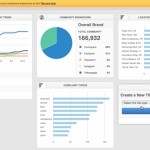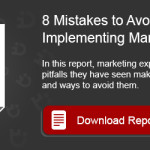Brand Owners Use Location Analytics Lens to View Social Media …

A demonstration view of a Venuelabs dashboard showing customer activities including complaints.
If there’s a complaint on Facebook about restroom hygiene at an Applebee’s in Miami, what is the brand manager monitoring the national restaurant chain’s mentions on social media supposed to do?
Contact managers at each of the chain’s five eateries in the area? Start a spreadsheet tracking all comments in South Florida? Reiterate corporate policies about regular lavatory cleanups at all its restaurants across the nation?
The need for more data is clear. And while marketers have been analyzing social media sentiment for clues to market signals for several years, correlating this social media signal with location data can determine whether this Facebook mention represents a marketing issue, an operational problem to fix, or an outlier. This use case for location analytics describes the work of developers at Seattle-based Venuelabs, which counts as customers Applebees and large retailers like Albertsons, as well as regional and local outlets. In all, the company monitors social media activity for approximately 500,000 locations owned by 3,500 brands in 15 different B2C categories, with retail, restaurants and convenience stores the largest customer groups.
Related Stories
Geofeedia Structures Twitter, Social Media Data, by Location and Time
Read the story »
Guide to Sentiment Analysis
Read the story »
Risk Managers Visualize Fresh Correlations by Analyzing Location Data
Read the story »
Focus On: Location Analytics
Read the story »
“Many brands are focused on general media mentions. The missing link is location,” said Neil Crist, CEO of Venuelabs, which he founded in 2008. “Location is about [that fact that] we know they were there. The comment reflects a sentiment based on experience.”
Location analytics is a potential competitive differentiator, according to Ventana Research. An August 2013 Ventana survey of 261 business managers and users found that one in three respondents said their implementations had significantly improved their business results, while half said location analytics had improved results slightly. American smartphone users, meanwhile, are a ripe source of data: 12 percent use a geosocial service such as Foursquare to share location information, a Pew Research Center study in September 2013 found. (That figure was down from 18 percent noted in a 2012 survey.) Globally, smartphone sales grew by 39 percent in 2013 to more than 1 billion units, IDC reported.
Venuelabs is not the only application developer correlating location data from smartphone owners’ interactions and other social media users. Geofeedia, for example, allows users to create a map view of posts from Twitter, Instagram and other major services—a service designed for marketing which has proven useful to both law enforcement and the media. And academic researchers have showcased the potential for more, creating visual displays to examine local neighborhood behavior patterns in Foursquare posts and the political sentiment on Twitter during the Arab Spring in Cairo.
A key difference with Venuelabs is the mix of technology and human labor involved in creating analytical views of the data. Its dashboards rely on a staff of between 15 and 20 people to categorize consumers’ input across more than 120 social media channels and local consumer sites. Another difference is that Crist makes no secret of the fact that getting value from the custom-built or customer-developed dashboards often requires practice and training that his team provides. The key is to help brands translate the data into insight that is meaningful and actionable, he said. Pricing starts at $5 per location per month.
Going Broad and Deep, with Human Help
As Venuelabs has developed its dashboard-based application, Crist said the company has learned that it takes both analytics capabilities and human intelligence to understand the nuance of mentions on Twitter, Foursquare, Facebook and many other consumer sites. The core idea is to help brand owners manage their local presence by seeing and listening to their local customers at the point of purchase, to identify and manage important points of presence and to engage customers, he said.
Neil Crist of Venuelabs
Diving into the streams turns up both structured data – a rating on Yelp, for example – with unstructured data points from a shared Tweet, a Facebook like, an Instagram or Foursquare mention, or a buying tip posted on Pinterest. There’s far more unstructured data than structured. Venuelabs has found consumers typically use three to four mobile apps to engage with brands and merchants. “For any given brand, we see 15 to 20 distinct channels and sites that are important” for each location,” Crist said.
That’s the broad part. The deep part comes with the help of staff who categorize comments into categories like product feedback, staffing issues, praise, location cleanliness, and “needs attention.”
Correlating these categories by location, Venuelabs users can build dashboards that provide windows into performance from a marketing or operational perspective, focused on a region or a specific location. They can establish benchmarks and track data over time to measure the success of a local coupon offered via social media, the progress on engaging customers in a certain city, and compare outlets in one region of the country to another.
And while Venuelabs initially set out to help marketers, the use cases have grown. For example, one customer, a gas station retailer, noticed that customers were complaining about certain lanes at the pumps were blocked when lines of motorists were waiting for fuel. It turned out that the company had made an error in training staff about the timing of cleaning the areas around the pumps. The analytics “allowed them to see a systemic pattern and address a training issue at the regional level,” Crist said.
When Social Media Analytics Becomes Organic
If a smartphone can feel like an organic part of a person’s life, it only makes sense that PCC Natural Markets, a nine-store natural food retail cooperative in the Puget Sound region of Washington would have a social media specialist.
Ricardo Rabago of PCC Natural Markets
Ricardo Robago, who has held that title for about five years, notes his company serves a lot of technology-savvy consumers who care passionately about the sourcing and freshness of their food. That the retailer was on Twitter early enough to grab a three-letter handle, @PCC, reflects its desire to engage where its customers spend time, Robago said.
An application like Venuelabs puts a framing structure around a disorganized stream of activity. “You can see that when customers leave a store, they will tweet, Yelp, check in and share that with family and friends. And by doing that, we can understand if we are doing a good job, and if we’re not, what do we need to do,” he said in a recent interview.
Robago said Venuelabs fits into a set of tools PCC uses to listen to social media and to engage consumers proactively on issues ranging from the daily deli offering to public policy issues that influence the organic food industry in the state. Other social media monitoring tools in use include SproutSocial and SumAll.
The communication on social media goes beyond what consumers say about a brand—it’s multi-directional. And analyzing that activity opens eyes about opportunities to improve performance, said Nancy Crouch, director of loss prevention and safety for Maverik, a convenience store and gas retailer with 250 locations in 11 western states.
“It’s amazing how many people share their experiences (big and small) with each other (friends and strangers alike) over social media,” Crouch said by way of email. “Being aware of new trends and fads that the customers are talking about, will allow the company to react quickly to increase sales, which, in turn, increases profit from which all departments can benefit. It may also allow the company to ameliorate a negative issue more quickly.”
It’s about the signal and the noise, Crouch said. “Venuelabs has the ability to make a custom dashboard to sort out the incredible amount of chatter out there, allowing the company to decipher what should be handled or let go as harmless chatter.”
Michael Goldberg, the former editor of Data Informed, is an independent writer and editor based in the Boston area. Email him at [email protected].
// ]]>
View article:
Brand Owners Use Location Analytics Lens to View Social Media …




